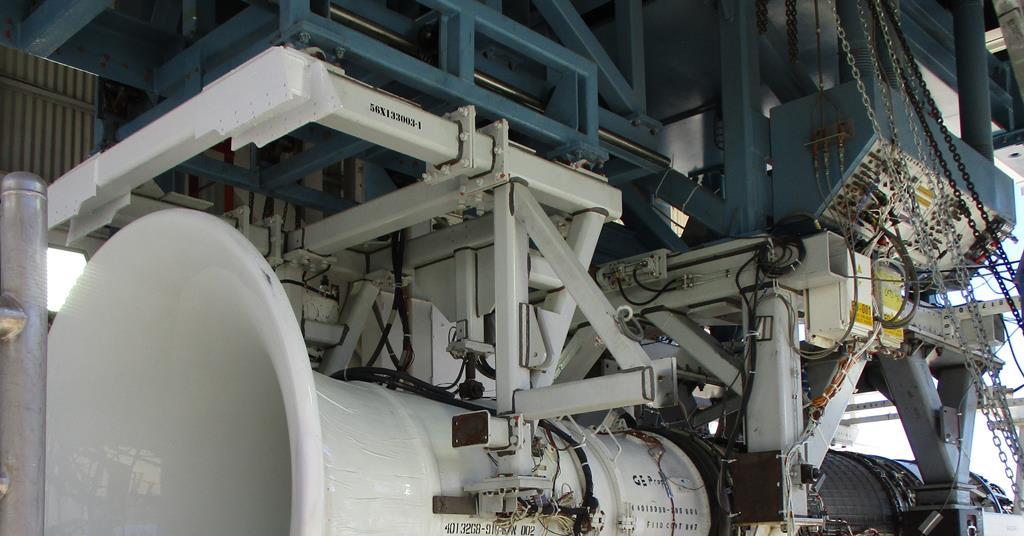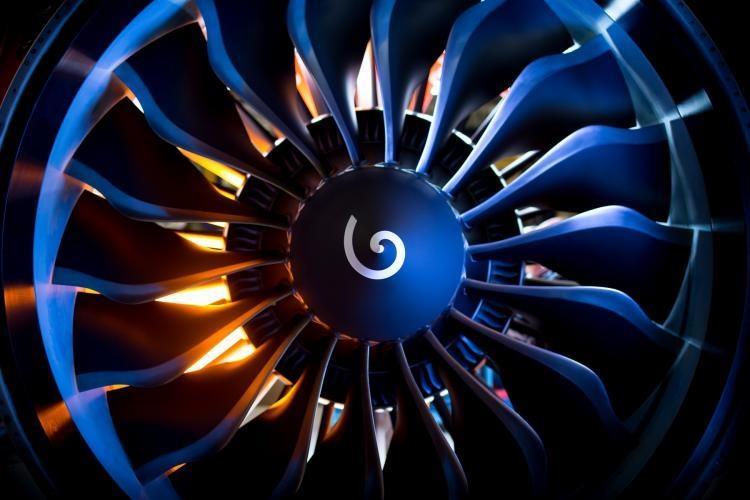The third stream enhances particle separation while providing variable bypass.
Adaptive engines traditionally have been associated with military propulsion. But as CFM International digs deeper into next-generation propulsion technology, the engine-maker is turning to the idea for its future commercial powerplant.
Like the U.S. military adaptive engines in development, the application of a form of variable cycle in the open fan study under the Revolutionary Innovation for Sustainable Engines (RISE) initiative is based on control and manipulation of a third stream of airflow outside the conventional core and bypass flows.
- Variable bypass enables smaller fan
- Third stream centrifuges out dust
However, while the overall principle is similar in both military and civil engines, the reasons for adopting the concept for the open fan are notably different, the GE Aerospace-Safran Aircraft Engines joint venture says. Unlike its military counterpart, in which the third stream is varied to increase either combat power or cruise efficiency, the RISE design aims to use the third flow to make the engine more durable and easier to install.
In a military adaptive engine, the added airflow is used to boost either mass core flow for greater acceleration or bypass ratio for greater range. In RISE, the third stream is intended to increase effective bypass ratio, and therefore efficiency, without a large expansion in fan diameter, making installation simpler. At the same time, it is designed to enable lower core operating temperatures and reduce dust ingestion, both of which should lead to greater overall durability.
Dust ingestion durability tests of advanced high-pressure turbine blades for the compact RISE core are underway using an F110 engine. Credit: CFM International
“It’s something we’ve been working toward all along as one of the benefits of the open fan architecture,” says Arjan Hegeman, vice president for future of flight at GE Aerospace. Now that tests of the system have quantified the expected benefits, he adds, “we can start talking about it more publicly.”
In the open fan design, the third stream enters the inlet behind the single-stage fan and passes through the intermediate section containing the fan gear system and on which the variable guide vanes are mounted before exiting the engine and merging with the external fan bypass stream. Although further details have not been revealed, it is likely that a splitter in the inlet would be used to divert flow into the fan bypass or core as needed.
“I can make the bypass larger or smaller,” Hegeman says. “The larger I make the bypass, the higher the fuel efficiency, but you get a little less thrust responsiveness. So for takeoff, when you want a more rapid thrust response, we make the core flow larger and the bypass flow smaller by manipulating that third stream. If you don’t do it with a third stream, the only other way to do it is with a larger fan.”
The adaptive approach “allows for a smaller fan size, and you still get the right thrust responsiveness when you need it without giving up any efficiency,” Hegeman says. Ducting more airflow through the core at higher power settings increases mass flow and fan pressure ratio. Conversely, as the third stream is mixed with the fan bypass, the effective bypass ratio increases while the fan pressure ratio decreases.
The design helps improve durability—a key parameter for the open fan. “Clearly, for next-generation engines, durability and maintainability are going to be as important as fuel burn,” Hegeman says. “If you hit your high fuel burn efficiency target, but it doesn’t meet the durability target, then from an overall operations cost perspective, you still haven’t gained anything for the operator.”
The adaptive approach helps bolster durability in two main ways. First, by improving the overall propulsive efficiency, it reduces the imperative to rely solely on boosting thermodynamic performance in the core with higher temperatures and pressures. Although the push to higher overall pressure ratios and turbine inlet temperatures in recent high-bypass turbofans has helped drive down fuel burn, the extreme operating conditions—particularly in challenging environments—have exposed vulnerabilities to turbine blade and nozzle erosion, among other durability issues.
Second, the additional flow acts as a “fantastic centrifugal filter,” reducing ingestion of dust and particulates into the core, Hegeman explains. “It filters out so much dust and debris that normally get sucked into that high-pressure, high-temperature part of the engine, and that really is a durability challenge,” he says. “All that gets filtered out and expelled out of the engine before it gets into the core and it goes into the bypass. The data we have now suggest that we should be able to get operators in harsh environments to be close to the same experience as today’s operators in neutral environments.”
Having recently completed critical design review for the open fan, CFM is “much more converged on what that is going to look like for both the demonstrator as well as a product that we would do afterward,” Hegeman notes. “So with those flows much better defined, you can really start quantifying how much filtering of ingested dust you really get. The number is higher than what I was expecting. So that’s the good news and the new finding.”
One benefit of the third stream that the open fan shares with its military engine counterpart is additional cooling. As part of RISE, CFM is studying incorporating in the engine a hybrid--electric system, which is undergoing tests using a modified GE Aerospace Passport engine..
“It is an extremely effective heat sink,” Hegeman notes. “You recover the thrust out of the heat that you dump into the third stream. Everything in this architecture is driving toward efficiency, so when we add hybrid electric into that, you need to manage the heat loads that come with that. This means instead of just wasting the heat, you are recovering thrust out of it by having heat exchangers in that third stream.”
CFM’s acknowledgment of the adaptive design feature comes as it begins key dust ingestion tests on the new high-pressure turbine blades and nozzles at the center of the future small-core design. Tests are being conducted with a specially adapted GE Aerospace F110 military engine at a company site at Edwards AFB, California.
The evaluation targets improved durability in harsh operating environments and involves injecting a bespoke mix of sand and other particles developed by GE into the inlet. Building on similar durability tests developed for other CFM and GE commercial engines—including the Leap-1, GEnx-1B and GE9X—the ingestion work evaluates the interaction of molten particles of a calcium-magnesium-alumino-silicate (CMAS) mix with the thermal barrier coatings (TBC) that protect the turbine blades and nozzles.
TBC are key to enabling the engine to operate at temperatures up to 1,200C (2,200F). CMAS issues can degrade coating performance, leading to blade erosion and—in the worst cases—component failure.
The dust tests follow more than 3,000 endurance cycles on the high-pressure turbine completed this year, as well as an earlier series of tests to validate thermal, mechanical and system performance. Endurance tests of the turbine and nozzle components included simulated high-thrust takeoff and climb to see how parts would withstand flight conditions. CFM has conducted more than 350 tests to date under the RISE initiative.

 www.aerotime.aero
www.aerotime.aero

 www.aerotime.aero
www.aerotime.aero



